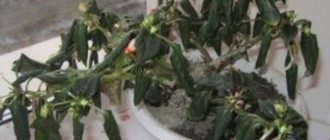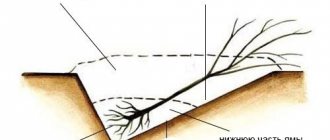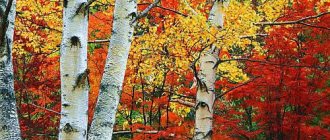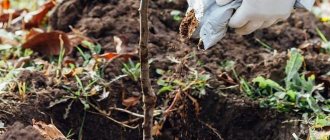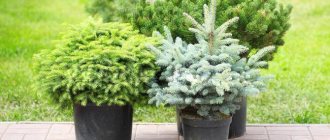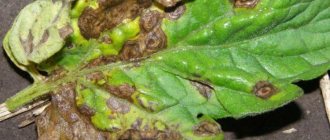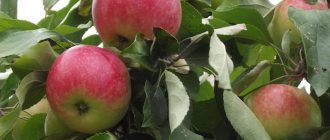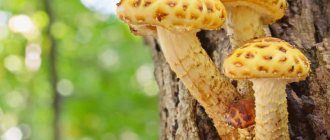Home Diseases and pests
The main diseases of fruit and berry crops include black cancer, goiter, scab, gum disease and all kinds of rot. Also common diseases of fruit plants include powdery mildew, anthracnose and white spot. To combat diseases of fruit trees and berry bushes, it is necessary to carry out a number of agrotechnical measures and do not forget to destroy the affected parts of the plants.
- 2 Scab disease of fruit trees: photos and treatment
- 3 How to deal with root canker disease of fruit trees
- 4 Fruit tree disease fruit rot: photos and treatment
- 5 Combating disease of stone fruit crops with gum treatment
- 6 Gooseberry disease powdery mildew and control measures
- 7 Currant anthracnose disease and its treatment
- 8 How to deal with white spot in strawberries
Fruit tree disease black cancer and its control
Black apple tree cancer in the photo
Black cancer is a dangerous disease of fruit trees that affects the bark of the trunk and branches, as well as the fruits and leaves of apple and pear trees. The causative agent of the disease is a fungus (spheropsis). It penetrates into the bark through mechanical damage and areas of sunburn.
As can be seen in the photo, with this disease, gray depressed oily spots appear on the bark of fruit trees, which subsequently turn black and become covered with brown dots:
Gray sunken oily spots appear on the tree bark (photo)
The bark of the tree turns black and becomes covered with brown dots (photo
The lesion spreads to the wood and increases in area every year. With ring bark disease, the branch usually dies. But partial damage to the bark around the circumference of the trunk or skeletal branches, disrupting the supply of water and nutrients, to one degree or another weakens the development and yield of the tree and shortens its longevity.
Fruits are also affected by the fungus through mechanical damage. The fungus penetrates the leaves through the skin. Damaged fruits rot and leaves fall off prematurely.
Measures to combat black cancer disease of fruit trees:
- Collection and removal of fallen leaves and fruits from the garden.
- Cutting out dry branches and affected areas of bark to healthy tissue, disinfecting the wounds with a one percent solution of copper sulfate and applying garden varnish. The cuttings are removed and burned.
- Application of a set of measures to care for the trunk and branches of tree bark.
Cytosporosis disease
A lover of tree bark, causing some areas of it to dry out. The bark is captured by ulcers (dark), which quickly spread, gradually acquiring a red-brown color. All actions aimed at peeling the affected area lead to loosening of the bark, which dies after some time. A certain number of branches also die, and subsequently both young and old trees may die.
The disease’s companions are favorable weather (frost or dryness), waterlogged, heavy, very poor soil, and of course, insufficient care of the crop.
Our actions.
In the spring, during the swelling of the buds at 15 ° C air, a prepared composition of 40 g of the drug “Hom” - 10 liters. We spray the liquid. We do the next one with the same composition just before flowering, and the third after it ends. For an adult, large plant we spend 3-4 liters, for a small one 2 liters will be enough.
To increase resistance to cold, apple and pear trees can be fed with phosphorus and potassium.
Somewhere after the 10th of November, trunks with large skeletal branches, having previously been cleared of old bark, must be whitened in two layers. Whiten with the following mixture: we need a kilogram of lime, an Iskra DE tablet, 40 g of soap (tar), 2 kg of clay, 2 tablespoons of glue (stationery), with good mixing.
You can do such an event at the very beginning of March.
In the spring, we must cut down the diseased branches, and then let the fire work, and clean out any small spots found, then cover them with a mixture of whitewash or treat them with any of the listed preparations.
Scab disease of fruit trees: photo and treatment
Scab in the photo
Scab is a disease of fruit trees that damages fruits and leaves (photo)
Scab is a disease of fruit trees that damages the fruits and leaves of apple and pear trees. Caused by a fungus (fusicladium) that overwinters in fallen leaves. Olive-green velvety spots filled with mycelium and fungal spores form on leaves and fruits affected by the fungus. If it spreads heavily on the leaves, it causes them to fall off prematurely. Scab-affected fruits often change shape and the spots on them crack. More severe scab development is observed in years with a rainy spring. Scab weakens the development of trees, reduces their yield and the commercial quality of the fruit.
To protect fruit trees from scab disease you must:
- Destruction of infected leaves, fruits and branches.
- Spraying trees with a 3-5% solution of iron sulfate in the fall or early spring, before the buds open.
- Spraying with one percent Bordeaux mixture during the period of bud release and after flowering.
Look at the photo “Diseases of fruit trees and their treatment”, which shows all the main agrotechnical measures to combat scab:
For scab disease, it is necessary to destroy infected leaves, fruits and branches (photo)
Trees need to be sprayed against scab disease (photo)
Bacterial burn
The first cases of bacterial burns have been known since the 18th century. Today, this disease is widespread, and all fruit crops are susceptible to it, although apple and pear trees suffer the most. Pathogen bacteria spread from diseased trees to healthy ones, sparing neither young nor old plants, and can destroy an entire garden in just one season.
Bacterial burn on wood appears as dark, watery spots. The shoots and foliage turn black and look as if scorched. The inflorescences quickly “burn out” and fall off. The fruits, if they manage to set, darken and dry out.
The bark softens and becomes covered with cracks through which white liquid appears. The white drops quickly turn yellow and look like mushroom spores. The bark bulges, cracks and takes on a strange brownish-red color with a marbled pattern. Ulcerations form on the branches.
For prevention, garden plants are regularly treated with insecticides to prevent the spread of fire blight by insects. They also destroy all wild fruit crops at a distance of 150 m from the garden. Hawthorn is often the carrier of the disease and must also be destroyed.
A bacterial burn is treated with antibiotics:
- gentamicin,
- rifampicin,
- kanamycin, streptomycin,
- chloramphenicol and nalidixic acid.
Before treatment with antimicrobial agents, diseased parts of the wood are removed and the sections are treated with copper sulfate. All these funds are used in May - early June.
Copper sulfate or Bordeaux mixture is used against bacterial burns, but solutions of copper-containing preparations should not be highly concentrated. Plants do not need additional burns of leaves and wood.
Bacteriosis
Signs of bacteriosis are peeling of the bark and cracks. In this case, darkening and drying of the tissues under the bark are observed. Most often, gardens located near swamps, lakes and other bodies of water are susceptible to bacteriosis. High humidity and insect attacks contribute to the spread of infection.
For prevention, they clean after winter and remove all shoots weakened by frost. In the fall, remove the leaves and spray the garden with a solution of copper sulfate. In early spring, the trunks are whitewashed with lime with the addition of copper-containing products. Wounds and cracks are covered with garden varnish.
For treatment, the affected areas are cleaned, including healthy wood, the wound is treated with copper sulfate and wrapped with a cloth soaked in a similar composition. After 10 days, the bandage is removed. If the signs of the disease have disappeared, the wound is allowed to dry for 2 days, and then it is covered with garden varnish. If the disease has not disappeared, the stripping and further processing procedure is repeated.
During the treatment period, fruit plants are fed with nitroammophoska 30 g/10 l or any potassium-phosphorus fertilizers are used. Nitrogen fertilizing is not recommended at this time.
How to deal with root canker disease of fruit trees
Fruit root cancer in the photo
Root canker, or root goiter, is a disease of fruit crops that affects the lint of apple, pear, plum and other fruit and berry crops. When the disease occurs, growths form on the roots. The goiter of the affected roots increases from year to year, despite the annual destruction of growths in the fall. The disease is caused by a soil bacterium. Infection occurs mainly through mechanical damage to the roots.
With severe disease of the root system, the development of the tree is weakened. The most dangerous is goiter on the root collar and areas of roots near it; On thin roots, the disease has little effect on plant development.
In the process of dealing with root canker disease of fruit trees, the following measures must be taken:
- Careful selection and release of intact planting material from the nursery. If there is goiter on the lateral roots, trim them to the healthy part, followed by disinfection by immersing the seedlings for 5 minutes in a one percent solution of copper sulfate. Rejection of seedlings with growths on the root collar.
- Also, to treat this disease of fruit trees, it is necessary to apply mineral fertilizers to infected areas.
Remember
- Treat diseases immediately. As soon as you notice deterioration, take action. Diseases can spread throughout the garden. Some are difficult to spot right away, so inspect the trees carefully.
- Water the garden trees. But do not overwater the plants, otherwise they will become vulnerable to pests and fungal diseases. The optimal soil moisture for fruit trees is 60–70%.
- Lubricate the damage, for example, with copper sulfate. If you notice a broken branch or a scratch on the bark of a fruit tree, immediately treat the damage with a solution of copper sulfate, then lubricate it with garden varnish. Mechanical damage is the most common cause of fruit diseases.
- Treat trees against parasites . Pests gnaw through the foliage and bark of trees, through which dangerous fungal diseases penetrate.
Fruit tree disease fruit rot: photo and treatment
Fruit rot in the photo
Fruit rot is a disease of fruit trees that affects apple and pear fruits. Caused by a fungus (sclerotinia). In wet years, as well as in irrigated gardens, the disease develops more strongly. Spots appear on the affected fruits, which soon spread to the entire fruit. Gray pads appear on the surface of these spots, arranged in the form of concentric circles. Rotten fruits fall off, but some remain on the tree and dry out. Infection of fruits with fungus occurs when there are mechanical damages on them. When an infected fetus comes into contact with a healthy one, the latter is also affected.
To combat fruit tree disease, fruit rot, you need:
- Cleaning and destruction of rotten fruits.
- Cutting dry branches.
- Spraying the garden with a 5% solution of iron sulfate before the buds open.
- Carrying out a set of measures against pests that damage fruits.
Stone fruit rot affects the fruits of cherries, plums, sloe and other stone fruits. Caused by a fungus (monilia). The course of the disease is similar to fruit rot of pome trees.
The control measures are the same as for fruit rot of apple and pear trees.
The photo “Diseases of fruit trees and their treatment” shows how you can fight fruit rot:
For the disease fruit rot, you need to cut out dry branches (photo)
Trees need to be sprayed against fruit rot disease (photo)
Causes of diseases
Prevention is always easier than cure. Therefore, it is important to know the causes of the occurrence and development of diseases in fruit crops.
The most common of them is mechanical damage to the shoots, leaves and bark of fruit trees. Such damage occurs at any time of the year. In winter, this occurs due to heavy snowfall and freezing rain. In the cold season of the year, rodents pose a great danger. The bark and young shoots suffer from their sharp teeth.
In summer, leaves tear and branches break from strong winds, rain and hail. The green parts of the plant and the root system are destroyed by insect pests. The dangerous cause is often the person himself. For example, the trunk of an apple tree can be easily damaged by careless processing in the spring; branches may be damaged during harvesting.
Important! Even a small crack on the trunk of a plant can become a favorable environment for the penetration of pathogenic organisms.
Another cause of disease and even death of trees is thermal damage. They arise as a result of high or low temperatures. For example, in frosty winters with little snow, the wood of the trunk and branches freezes. As a result, the vascular system of trees is destroyed. In spring, mineral nutrition of plants is sluggish, which leads to its death.
Summer heat, as well as frost, can lead to disease in fruit trees. Under the scorching rays of the sun, burns form on the bark and leaves. They lead to the development of necrosis. This in turn reduces the rate of photosynthesis and, accordingly, reduces the quality of organic nutrition. In this case, the fruits develop poorly. They are small and often ugly.
One of the main causes of disease in fruit trees are pathogenic microorganisms: fungi, bacteria and viruses. This leads to the development of such dangerous diseases as putrefactive necrosis, powdery mildew, infectious chlorosis, rust, scab, and vascular mycosis. Dangerous pathogens inhibit the vital activity of the plant and disrupt metabolic processes. As a result, crop yields drop sharply.
May contribute to reduced yields
Numerous agricultural pests - insects, mollusks, spiders and mites - infect gardens en masse. Voracious caterpillars, bark beetles, codling moths, leaf rollers and silkworms damage everything. As a result, tree development stops, which can cause death. If the apple tree survives, you shouldn’t expect a rich harvest from it next year.
Dangerous diseases of fruit trees can be caused by a deficiency or excess of minerals in the soil. Thus, pale green small leaves of the plant are a signal of nitrogen deficiency. Weak chlorosis between the leaf veins will tell the gardener about a lack of soil potassium. Brown spots on leaves indicate copper deficiency.
Fighting disease of stone fruit crops with gum treatment
Gum discharge (gommosis) in the photo
Gum disease (gommosis) is a common and dangerous functional disease of stone fruit crops, which affects the trunks and skeletal branches of cherries, plums, damsons, sloe and other fruit trees. Plants of all ages are affected.
The disease is associated mainly with frost damage to tissues, as well as mechanical, insect and fungal damage.
The disease occurs during the growing season of plants and is accompanied by the gradual destruction of the membranes of newly emerging cells and the starch that accumulates in them, as well as intercellular substances, turning them into a mucous, gummy mass. Much of the gum that accumulates in the affected areas of wood and bark flows onto the surface of the bark. As it hardens, it creates a barrier to the movement of water and nutrients through the vessels. The degree of damage by gommosis can vary - from small cracks to a large area around a branch or trunk. When the cambium is damaged, swellings form on the branches. Sometimes no gum leakage is observed from the affected internal tissues.
Look at the photo - with this disease of fruit trees, the affected branches or trunks partially or completely dry out, especially in young plants:
When gum disease occurs, the branches or trunks of the tree in the photo are affected
Gum formation (gommosis) is a common and dangerous functional disease in the photo
Hommosis weakens the development and reduces the yield and longevity of trees. In the region, cherries are most susceptible to gum disease, followed by plums, especially varieties less adapted to local climatic conditions.
Observations have established that in lower areas with moist soils, cherry trees are more damaged by gommosis than in more elevated areas. Excessive application of organic fertilizers can also be the cause of the disease.
To treat fruit trees from gum disease (gommosis), you need:
- Appropriate selection of varieties.
- Choosing the right landing site.
- Application of an agricultural complex of measures to care for plantings and treatment of damaged trees.
Moniliosis
The disease affects cherries, plums, peaches and apricots. Brown spots appear on the fruit, which quickly multiply and cover the entire surface. Diseased fruits remain on the trees and turn into deformed black mummies. Some of the affected fruits fall off. During the period of full flowering, the plant is sprayed with one of the preparations: Riza, Sirius, Torsin.
Moniliosis of stone fruit trees
Gooseberry disease powdery mildew and control measures
Powdery mildew of gooseberries in the photo
Gooseberry powdery mildew (spheroteca) is a dangerous disease of berry bushes caused by a fungus (spheroteca). On young shoots, berries and leaves, a white powdery coating first appears, gradually thickening and turning brown. The plaque on the fruits is especially noticeable. They stop growing, often crack or dry out. The yield decreases sharply and loses its marketable qualities. The leaves curl up and do not develop, the shoots bend and dry out. The disease spreads by spores throughout the spring and summer. The fungus develops most strongly in humid, warm years.
Control measures:
- Avoid low, damp places when planting gooseberry plantations.
- Observe high agricultural technology for caring for the soil and bushes, avoiding their thickening.
- Collect and destroy damaged fruits, trim damaged shoots, rake and burn leaves.
- Before the buds open, spray with a 3% solution of iron sulfate.
- After bud break, before flowering, spray with 0.2 percent calcium arsenous acid with double the amount of lime
- Spraying four or five times after flowering with the same composition every 5-10 days. You can spray with soda ash and soap. Take 40 g of soda and 35 g of soap per bucket of water.
Folk remedies
Not all gardeners and gardeners, when faced with rust on their property, use chemicals to combat it. If possible, they try to replace them with less harmful folk remedies. This fungal disease can be combated with the following most effective folk remedies:
- Add one crushed aspirin tablet, 1 tsp to four liters of water. dishwashing detergent and 1 tbsp. l. vegetable oil and soda. The bushes are sprayed with this product regularly once every 7 days.
- Fill the bucket a third with fresh manure and add water to the brim. The infusion will be ready after three days, during which it must be systematically stirred. The product filtered through a cloth is diluted with water in a ratio of 1:10 before use. Treat the bushes with a fresh solution only in the evening, when the sun has set, otherwise burns will appear on the foliage.
- The bucket is half filled with finely chopped weeds, and then it is filled to the brim with hot water. The infusion needs to be stirred periodically; it will be ready after a few days. The product, filtered through cheesecloth, is sprayed on the foliage of the bushes in the evening.
Rust on plants. Symptoms, pathogens and treatment.
Watch this video on YouTube
Currant anthracnose disease and its treatment
Currant anthracnose in the photo
Currant anthracnose affects currant leaves, especially red currants. The disease is caused by a fungus whose spores overwinter in fallen leaves. As the summer progresses, new spores emerge, spreading the disease. Brown spots appear on the affected leaves, the leaves curl and fall off. The bushes become bare prematurely. The fungus also spreads to the stalks, which weakens the development of the berries.
Diseased bushes are weakened in development, the yield and commercial quality of the berries are reduced.
Control measures:
- Collection and destruction of fallen leaves.
- Spray three to four times with a one percent solution of Bordeaux mixture.
How to deal with white spot in strawberries
White spotting of strawberries in the photo
Strawberry white spot is a disease of berry crops that affects the leaves of the plant. Round whitish-brown spots with a red border form on them, mainly in the second half of summer. The disease is caused by a fungus. With strong development, the leaves dry out en masse, which causes a decrease in next year's harvest. The fungus overwinters on damaged leaves. In spring, ripened spores are spread across the leaves, infecting them.
Control measures:
- Collecting and burning damaged leaves in autumn and spring.
- Spraying strawberries two or three times with Bordeaux mixture: the first - at the beginning of summer, before the spots appear, the next - 20 days after the first.
Disease control is a necessary and important part of the agricultural complex of measures for caring for fruit and berry plantings. It is carried out through the use of agrotechnical, mechanical, chemical and biological measures.
A complex of agricultural technology - plowing rows and digging tree trunks, cleaning bark, cutting land, etc. - helps to destroy pests and diseases. Mechanical measures to prevent and control pests and diseases include: laying trapping belts, collecting overwintering nests, caterpillars, eggs, collecting and shaking off beetles, cleaning bark and burning residues and other measures.
- Author: admin
Rate this article:
- 5
- 4
- 3
- 2
- 1
(9 votes, average: 4.9 out of 5)
Share with your friends!
